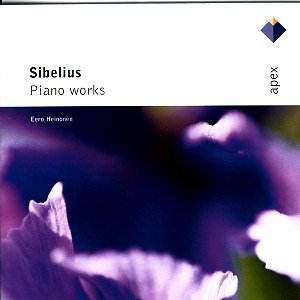Comparisons: Gimse/Naxos, Mustonen/Ondine
There are two points
concerning the piano music of Sibelius
that I feel need to be kept in mind.
One is that the piano was not a natural
instrument for Sibelius to communicate
his musical thoughts. The other is that
his ability to write appealing music
extended to his piano compositions.
Merging the two points results in attractive
music that does not reflect the masterful
orchestral works and symphonies that
Sibelius composed.
Sibelius wrote most
of his piano music in response to financial
requirements, while his strongest concentration
was saved for his large-scale works.
The variable quality of the piano music
is apparent in any recorded program,
ranging from disjointed and rambling
pieces to music of dramatic substance
and pieces that delight and sparkle.
However, you will not find any hidden
masterpieces, as the works do not plumb
deep emotional issues or offer the structural
coherence found in the works of outstanding
composers for the piano.
A few weeks ago I reviewed
for MusicWeb Volume 4 of Håvard
Gimseís traversal of the Sibelius piano
music on Naxos, finding the performances
warm and loving. The new entrant in
this repertoire is a Warner Apex reissue
of performances by Eero Heinonen recorded
in the late 1990s. Heinonenís program
is a fine one that highlights the more
serious and extended piano works of
Sibelius. The program includes the Opus
12 Piano Sonata and the piano arrangement
of Finlandia. There is also "Kyllikki",
a series of three pieces among the more
serious of Sibeliusís output.
Overall Heinonen imparts
greater substance to this music than
Gimse for Naxos. As an example, "Campanula"
from Op. 85 receives a flat and anonymous
reading from Gimse, while Heinonen offers
a variety of colors and sonorities that
makes the music come alive. Also, Heinonenís
soundstage is exceptional with fine
richness and clarity; Gimseís sound
is excellent but somewhat glassy in
the higher registers.
Heinonen begins his
program with the Five Characteristic
Pieces, Op. 103. This is an excellent
start as "The Village Church"
has a ceremonial first theme perfect
for ushering in a recorded program.
The piece also has a strong impressionist
element that can also be found in many
of the other higher opus numbered works.
The gem of the Opus 103 pieces is "The
Oarsman" which has a Spanish flavor
and flourish to it that reminds me of
the uplifting piano music of Enrique
Granados.
The most extended work
on the recording is the Opus 12 Piano
Sonata with its nostalgic and lovely
"Andantino" having delightfully
perky and pristine passages for exceptional
contrast. Also on the extended agenda
is the arrangement of Finlandia that
works fairly well in its piano guise.
The rumbling of the bass chords at the
beginning of the piece is highly effective
in Heinonenís hands, and he also fully
captures the workís poignancy.
I would have no problem
citing Heinonenís disc as the best single-disc
recording of Sibeliusís piano music
on the market but for the Olli Mustonen
offering from Ondine. Mustonen is on
a higher plane altogether with his wonderful
rhythmic elasticity and sharper contours.
Although the two discs only have in
common the Opus 68 Rondinos, Mustonenís
greater verve and emotional breadth
reveals additional emotional layers
only hinted at by Heinonen. For instance,
Heinonen prioritizes the mystery and
lush properties of the Rondino No. 1.
Mustonen also offers these qualities
but adds suspense and urgency through
changes in dynamics and the highlighting
of musical suspensions.
In summary, this newly
reissued Warner Apex disc is an excellent
representation of the piano music of
Sibelius. I think it likely that most
readers would want only one or two recordings
of the particular repertoire. Acquiring
the Heinonen and Mustonen discs is an
excellent route to take, especially
since the two only have about five minutes
of music in common. For those desirous
of the complete body of piano works,
Håvard Gimseís Naxos recordings
should fully satisfy except for some
loss in substance. Erik T. Tawaststjerna
on BIS offers another fine cycle, but
the Naxos price tag is considerably
lower with performances as rewarding
as on the BIS recordings.
I want to emphasize
that Sibeliusís piano music is not essential
except for ardent piano enthusiasts
and those who must have every note he
wrote. However, the piano music is certainly
appealing in it own right and well above
the level of pleasant background music.
Don Satz
